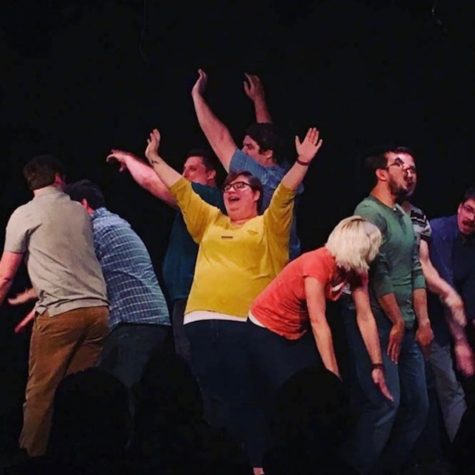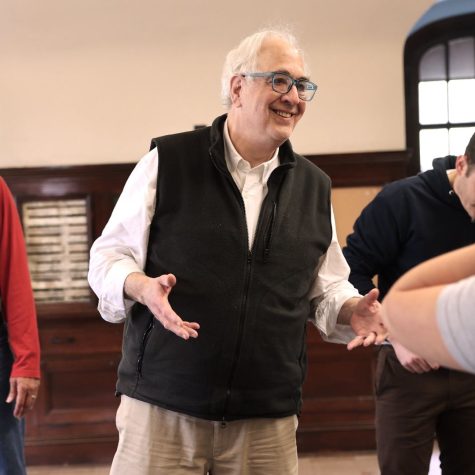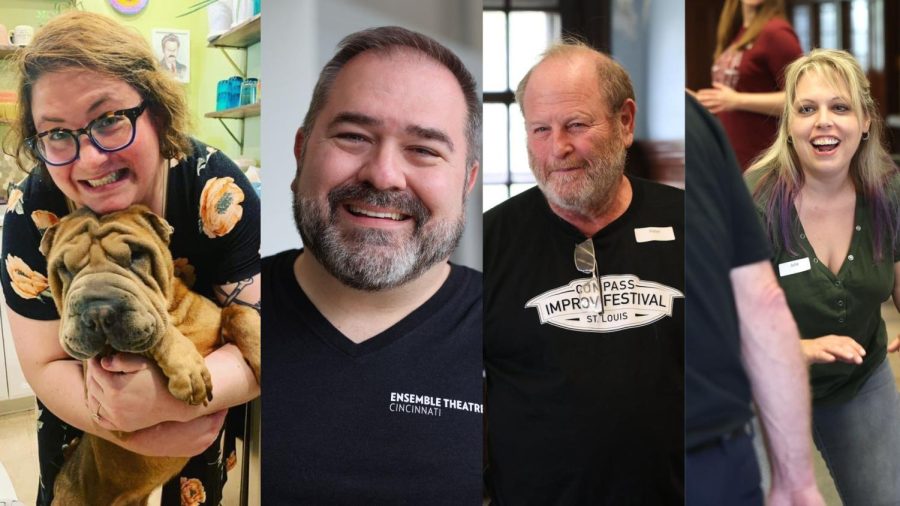For these comic actors, ‘improv’ also means ‘improvement’
Published June 7, 2023
Jen Weinman was going through a really hard time in her life. She was dealing with depression and had a bad breakup. Then she met a group of people who had a common interest: improv theater.
“I asked them why they chose improv and one of them told me, ‘Because I wanted to participate in life instead of observe,’ ” said Weinman, 40. She joined and discovered a like-minded community.
Weinman is among a group of Jewish St. Louisans who are part of the local improv scene. Some people gravitate to improv to conquer a fear of public speaking; others do it to meet new people. It is both an affordable and approachable hobby with a welcoming community and multiple entry points.
“It’s been a way to connect with other people,” she said. “Improv has changed all parts of my life in my family relationships, personal relationships, romantic relationships and professional relationships.”
Julie Bieniek Brown, who is preparing to teach high school, said improv helps enhance a person’s communications skills.
“I’ve never really had much of a fear of public speaking, but I know other people have,” said Brown, 41. “One of the guys that I used to see at the Improv Trick had to give presentations to people that he worked with. It was just for a room with 10 people, and that made him terrified. So he learned improv. We were doing large shows, and he was up there doing it like it was nothing. So to go from being scared in front of just 10 people to doing a show for 1,000 people, I mean, that’s a huge feat.”
Improv is not a substitute for therapy, but it can be therapeutic, said Katy Paul, who works in human relations.
“I got involved in 2009,” said Paul, 38. “I had just gotten married. I was a year out of college, and I was looking for adult friends. I’d always done theater, and I had dabbled a little bit in improv. I took a class, and I was hooked and ended up being part of the first Improv Shop graduating class. And now I teach there, I perform regularly. We get to be silly and play pretend in a way that you don’t normally get to do in your adult life.”
The plot and narrative of an improv show can meander just about anywhere because the performers make it up as they go. On a recent weekend night at the Improv Shop in midtown St. Louis, Paul and Weinman were onstage being silly. One of the bits involved a Burger King employee receiving a critical quarterly review from her supervisor. The employee had a poor attendance record, and she brought her children to work, leaving them to chill in the walk-in cooler.
Growing up, Scott Weinberg watched a lot of Comedy Central and “Whose Line Is It Anyway?” As an adult, Weinberg, who works in information technology, began listening to improv podcasts.
“I had just gone on a real big health kick and had achieved a whole bunch of other goals,” said Weinberg, 42. “I wanted to put myself out there more. And so when I started doing improv, it helped me be more vulnerable and then have deeper, more meaningful relationships. That includes the friendships and the relationships I’ve had with my partners. It opened me up a lot to be a more well-rounded person.”
Regardless of one’s occupation, improv offers a set of skills that can be beneficial, said Peter Barg, who has worked in TV production and animation and is the board president of Compass Improv.
“If you have worked for a big business, they have meetings, and they talk about listening,” said Barg, 67. “One of the biggest things that improv is about is active listening. Listening to what your partner is telling you or the visual cues of what your partner is doing, the way they’re looking at you. What improv does is it gives you a quiver of skills to work with. You’re also connecting with people that have a shared interest. It’s kind of nice to be in a room and know that you’re all there for the same reason.”
Improv participants quickly learn how to think on the fly out of necessity because there is no script. They build a sense of trust with their partners, who can pick up a thread of an idea. Often, improv shows start when an audience member calls out a word or subject. The improv troupe has mere seconds to begin a scene. There are no props, no cue cards. It’s up to the actors to create a reality for the audience by creating a plot out of nothing.
Jewish roots
It is precisely that sense of working without a net that is a big draw for performers who specialize in improv, such as Ed Reggi, who teaches improv at COCA and attends Central Reform Congregation.
“I was interested in acting in the theater at a very young age,” said Reggi, 52. “I was very fortunate that I had some fantastic teachers who exposed me to improv.”
Modern improv was pioneered by Jewish impresarios, producers and actors, Reggi said.
“There are a lot of connections to Judaism and Jewish people in the art form itself, like Viola Spolin, who was a Russian Jewish immigrant,” he said. “If it weren’t for Viola, we would not have what we call today improvisation at all. She wrote the first book on it in the late 1940s and early 1950s. Her son Paul Sills went on to found Second City.
“Those early days of improvisation as an art form started branching away from traditional acting. It just a way to connect to the audience, to bypass the idea of a playwright or a writer having to write the material. It gave access to the actors to do something immediate without rehearsing and paying royalties. It was literally like the most accessible form of entertainment in front of a live audience.
“It’s the only art form where everyone in the cast is the director. Everyone is a choreographer, everyone is the actor. We’re all doing it together at the same time. We are in the moment with the audience, sharing that experience live.”
Resources to learn
The Improv Shop offers beginner through advanced sessions with new sessions beginning every few months, Katy Paul said.

“We have a Level 0 for people who may be a little hesitant and don’t know a lot about improv,” she said. “They just want to get their feet wet. It’s very non-threatening. Then we also have a Level 1. There’s no pre-req to take Level 0. Part of what we do the first day is everybody talks about why they’re there. We get people who do it for the public speaking aspect. We also get a lot of people who just moved to St. Louis.”
A variety of entry points are available in St. Louis for new improv practitioners, Barg said.
“ComedySportz offers a drop-in every Monday night at the Pat Connolly Tavern,” he said. “Bob Baker offers a Thursday drop-in once or twice a month in person and online. He also offers a musical improv drop-in. Compass Improv is working to offer classes and opportunities.”
A recent Compass improv master class featured Jewish improv coach and instructor Michael Gellman, who has directed Tina Fey, Steve Carell and Gilda Radner.

COCA offers an improv theatre class taught by Reggi that is part of its Free@3 series. As the name suggests, there is no charge to attend.
In late April, Julie Brown created an improv training and resource website, Show-Me Improv.
“I’m going to start offering some classes,” she said. “It’s going to geared toward short form improv. We are going to be working on offering some basic Level 1 classes as well as some classes that will blend sketch comedy along with improv.”
myself out there more. And so when I started doing improv, it helped me be more vulnerable and then have deeper, more meaningful relationships. That includes the friendships and the relationships I’ve had with my partners. It opened me up a lot to be a more well-rounded person.”
Regardless of one’s occupation, improv offers a set of skills that can be beneficial, said Peter Barg, who has worked in TV production and animation and is the board president of Compass Improv.
“If you have worked for a big business, they have meetings, and they talk about listening,” said Barg, 67. “One of the biggest things that improv is about is active listening. Listening to what your partner is telling you or the visual cues of what your partner is doing, the way they’re looking at you. What improv does is it gives you a quiver of skills to work with. You’re also connecting with people that have a shared interest. It’s kind of nice to be in a room and know that you’re all there for the same reason.”
Improv participants quickly learn how to think on the fly out of necessity because there is no script. They build a sense of trust with their partners, who can pick up a thread of an idea. Often, improv shows start when an audience member calls out a word or subject. The improv troupe has mere seconds to begin a scene. There are no props, no cue cards. It’s up to the actors to create a reality for the audience by creating a plot out of nothing.















